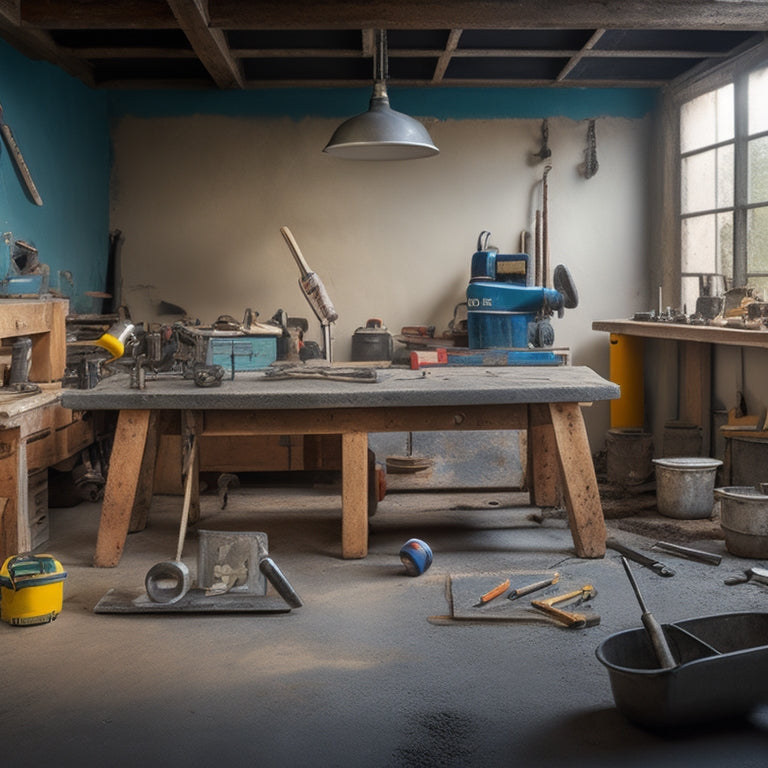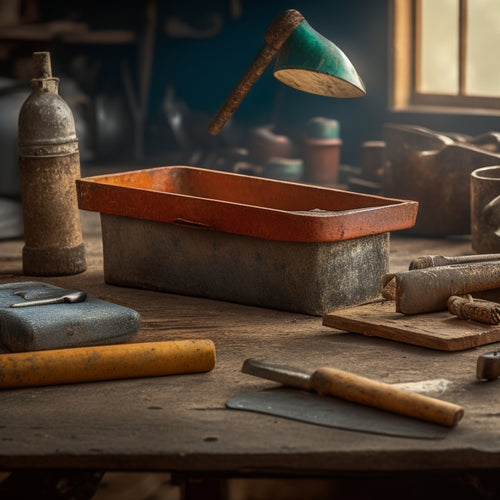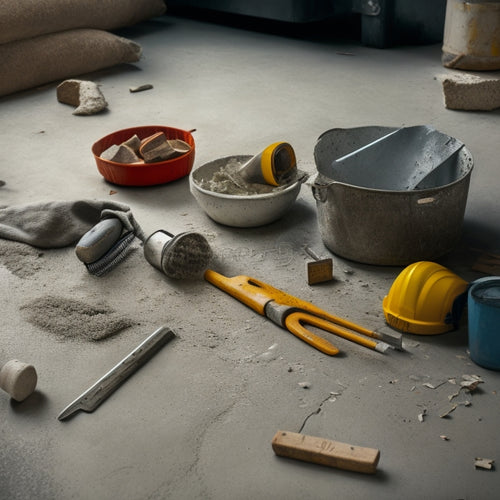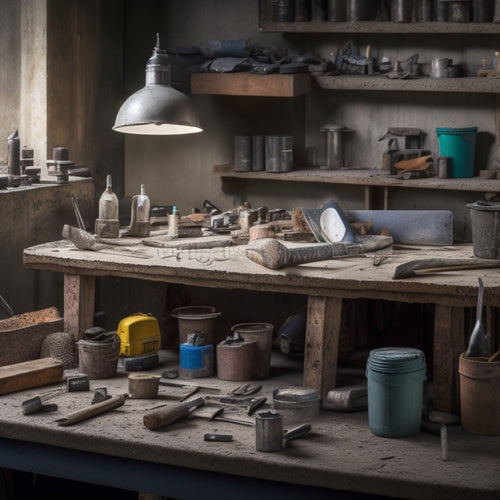
What Tools Do I Need for Concrete Finishing
Share
You'll need a variety of tools to achieve a professional concrete finish, including essential hand tools like trowels, edgers, and float and finishing blades. Power tools, such as power trowels, concrete grinders, and tamping tools, will also be necessary for smoothing and compacting the concrete. Additionally, you'll need edging and jointing equipment, finishing blades and bits, and curing and sealing tools to complete the job. Finally, don't forget safety gear and protection, measuring and testing devices, and specialized finishing accessories to guarantee a strong, durable, and aesthetically pleasing result - and that's just the beginning of what you'll need to know.
Key Takeaways
• Essential hand tools for concrete finishing include trowels, edging tools, float and finishing blades, and other specialized tools for specific techniques.
• Power tools like power trowels, concrete grinders, and tamping tools are necessary for smoothing and compacting concrete surfaces efficiently.
• Edging and jointing equipment, such as edgers, jointing tools, and edge cutters, are required to create clean edges and control joints.
• Finishing blades and bits, including diamond blades, polishing bits, and concrete scraper blades, are used for grinding, polishing, and removing old coatings.
• Safety gear, measuring devices, and mixing and applying tools, such as hard hats, safety glasses, and portable concrete mixers, are also essential for concrete finishing.
Essential Finishing Hand Tools
You'll rely on a range of essential finishing hand tools to achieve a smooth, even finish on your concrete surfaces. These tools will help you achieve the desired texture and finish and are vital for getting the job done right.
One of the most important hand tools you'll need is a trowel. Mastering various trowel techniques will allow you to achieve a range of textures, from smooth to rough.
You'll also need a range of edging tools, such as edgers, jointers, and groovers, to create clean lines, edges, and joints. Additionally, you'll need float blades and finishing blades to smooth out the surface and remove any imperfections.
With these hand tools, you'll be able to create a texture variety that suits your project's requirements. Whether you're going for a sleek, modern look or a more rustic, textured finish, having the right hand tools will make all the difference.
Power Tools for Smoothing
When it comes to achieving a high-gloss finish or smoothing out large areas of concrete, power tools become an indispensable part of your arsenal.
You'll want to invest in a power trowel, which is designed to smooth and flatten concrete surfaces. These tools typically feature a rotating blade that helps to remove imperfections and even out the surface.
For larger areas or more aggressive smoothing, consider using a concrete grinder. These machines are equipped with abrasive discs that can be adjusted to suit the specific needs of your project. Concrete grinders are ideal for removing old coatings, smoothing out rough surfaces, and preparing concrete for further finishing.
When choosing a power trowel or concrete grinder, consider the size and type of project you're working on. Look for tools with adjustable handles and ergonomic grips to reduce fatigue and improve control.
Additionally, make sure to select the appropriate abrasive discs or blades for your specific application. By incorporating power tools into your concrete finishing workflow, you'll be able to achieve a high-quality finish more efficiently and effectively.
Edging and Jointing Equipment
Finishing concrete edges and joints requires specialized equipment designed to tackle these critical areas where imperfections are most noticeable. You'll need the right tools to achieve professional-looking results.
When it comes to concrete edging, you're creating a clean, defined border that enhances the overall appearance of the concrete surface. Jointing techniques, on the other hand, involve creating control joints that help manage shrinkage and cracking.
Here are some essential edging and jointing equipment you'll need:
-
Edgers: used to create a clean, rounded edge along the perimeter of the concrete
-
Jointing tools: designed to create control joints, such as jointing trowels, jointing irons, and jointing saws
-
Concrete edging trowels: used to apply a clean, smooth finish to the edges
-
Edge cutters: for cutting and shaping concrete edges to precise angles and curves
-
Expansion joint fillers: for filling gaps between concrete slabs and other surfaces
With these tools, you'll be able to achieve precise control over your concrete edging and jointing techniques, resulting in a high-quality finish that's both functional and visually appealing.
Tamping and Compacting Tools
Two essential steps in the concrete finishing process are tamping and compacting, which require specialized tools to remove air pockets and excess water, ensuring a dense, uniform surface.
You'll need to master various tamping techniques to achieve the desired outcome. A tamper, also known as a hand tamper or rod tamper, is a must-have tool for this step. It's used to compact and flatten the concrete, removing any air pockets that may form. For larger areas, you might opt for a power tamper, which can save you time and energy.
Compacting methods are just as significant, as they help eliminate excess water and air from the concrete. A plate compactor or vibratory plate is perfect for this task. It applies pressure and vibration to the concrete, ensuring it's densely packed and even.
Additionally, you may use a roller compactor or screed board to further compact and smooth out the surface. By investing in these tamping and compacting tools, you'll be able to achieve a professional-looking finish that's strong and durable.
Finishing Blades and Bits
To achieve a high-quality finish, you'll need to equip yourself with the right finishing blades and bits, which are designed to remove imperfections, smooth out the surface, and add a professional touch to your concrete project.
These tools are essential for mastering various finishing techniques, from simple to complex. Here are some must-haves in your toolkit:
-
Diamond blades: Ideal for grinding and polishing concrete, these blades come in different grit levels for specific tasks.
-
Polishing bits: Used for honing and polishing concrete, these bits are available in various shapes and sizes.
-
Concrete scraper blades: Perfect for removing old adhesive, paint, or coatings from concrete surfaces.
-
Grout bits: Designed for mixing and applying grout, these bits guarantee a smooth, even finish.
-
Blade cleaning brushes: Essential for maintaining your blades, these brushes remove debris and residue, extending their lifespan.
Curing and Sealing Tools
When you're working with concrete, proper curing and sealing are vital to achieving a strong, durable finish.
You'll need the right tools to apply curing compounds, select the best sealants for the job, and guarantee moisture retention.
Curing Compound Application
Apply a curing compound to your freshly poured concrete to prevent water loss and promote proper hydration, guaranteeing a strong and durable finish. This vital step in concrete finishing helps maintain the desired appearance and prevents defects.
When it comes to curing compound application, you'll need to choose the right type and apply it correctly. Here are some essential considerations for effective curing compound application:
-
Select the right compound type: There are various curing compound types, including acrylic, polyurethane, and wax-based. Each has its own benefits and drawbacks, so choose one that suits your project's specific needs.
-
Prepare the surface: Confirm the concrete surface is clean, dry, and free of any debris or contaminants that might affect the compound's adhesion.
-
Apply the compound at the right time: Timing is critical; apply the compound when the concrete has reached the initial set, usually within 24 hours of pouring.
-
Follow the manufacturer's instructions: Read and follow the manufacturer's instructions for application rates, dilution ratios, and drying times.
-
Use the appropriate application tools: Use sprayers, rollers, or brushes specifically designed for curing compound application to guarantee even coverage and avoid over- or under-application.
Sealant Selection Criteria
Your concrete project's long-term durability and appearance depend on selecting the right sealant, which requires evaluating key factors such as compatibility, functionality, and environmental impact.
You need to take into account the type of sealant suitable for your project, as different sealant types offer varying levels of protection, aesthetics, and performance. For instance, acrylic sealers provide a glossy finish, while silane-based sealers offer excellent water resistance.
When selecting a sealant, think about the application technique you'll use. Will you spray, roll, or brush it on? Some sealants are designed for specific application methods, so make sure you choose a product that aligns with your technique.
Additionally, factor in the environmental conditions your concrete will be exposed to. If your project will be outdoors, you'll need a sealant that can withstand UV rays, rain, and extreme temperatures.
Lastly, evaluate the sealant's compatibility with your concrete mix design and any other materials used in the project. By carefully weighing these factors, you'll choose a sealant that meets your project's unique needs, guaranteeing a durable and attractive finish that will last for years to come.
Moisture Retention Methods
To guarantee a strong, durable concrete finish, you'll need to employ effective moisture retention methods, including curing and sealing tools that help lock in hydration and prevent premature drying.
Without proper moisture retention, your concrete may suffer from shrinkage cracks, weakened structures, and an increased risk of damage from environmental factors.
To ascertain your concrete finish meets the highest standards, consider the following moisture retention methods:
-
Moisture barriers: Apply a layer of moisture-resistant material to the soil or subbase to prevent water from seeping into the concrete.
-
Evaporation retardants: Use a specialized spray or coating to slow down the evaporation process, allowing the concrete to cure more slowly and evenly.
-
Curing compounds: Apply a liquid membrane to the concrete surface to prevent moisture loss and promote hydration.
-
Sealing tools: Use specialized equipment to apply sealants that protect the concrete from external factors and lock in moisture.
-
Curing blankets: Cover the concrete with insulated blankets to retain heat and moisture, promoting a stronger, more durable finish.
Safety Gear and Protection
Wearing the right safety gear and protection is vital when working with concrete, as it can be a hazardous material that exposes you to physical harm and health risks. You must comply with safety regulations to guarantee your well-being on the job site.
Protective clothing is a significant aspect of your safety gear. It shields you from skin contact with concrete, which can cause irritation, dermatitis, or even skin cancer. Here are some essential safety gear and protection you should wear:
| Safety Gear | Purpose |
| Hard hat | Protects your head from falling objects and debris |
| Safety glasses | Shields your eyes from concrete dust and debris |
| Dust mask | Prevents inhalation of concrete dust and silica particles |
| Gloves | Protects your hands from skin contact and abrasion |
| Steel-toed boots | Safeguards your feet from heavy objects and tools |
Measuring and Testing Devices
When you're working with concrete, it's essential to guarantee the mix is right and the surface is ready for finishing.
You'll need to measure the concrete's slump, which affects its workability and strength, and take surface temperature readings to determine the ideal time for finishing.
Concrete Slump Measurement
You'll use concrete slump measurement devices to determine the workability of freshly mixed concrete by evaluating its consistency and flowability. This is vital in guaranteeing that the concrete meets the required specifications for your project.
Slump testing is a common method used to evaluate the consistency of freshly mixed concrete. Here are some key aspects of concrete slump measurement devices you should know:
-
Types of slump cones: You'll come across different types of slump cones, including the Abrams cone and the K-slump cone. Each has its own unique features and applications.
-
Slump measurement ranges: Slump measurement devices can measure slump values ranging from 0 to 250 mm, depending on the type of device.
-
Digital vs. analog devices: You can choose between digital and analog slump measurement devices, each with its own advantages and disadvantages.
-
Calibration requirements: It's important to calibrate your slump measurement device regularly to guarantee accurate results.
-
International standards compliance: Look for devices that comply with international standards, such as ASTM or EN, to guarantee consistency in your slump testing results.
Surface Temperature Readings
As you move on to the concrete finishing process, measuring surface temperature becomes essential to confirm proper curing and prevent defects. This is where surface temperature reading devices come into play. These devices help you monitor the surface temperature effects on the concrete, confirming it doesn't get too hot or cold, which can lead to cracks, scaling, or poor finish.
You'll need to choose the right temperature monitoring techniques for your project. Infrared thermometers are popular for their ease of use and quick readings. They're ideal for large areas and can provide accurate readings within seconds.
Thermocouples, on the other hand, are more precise and suitable for smaller areas. They're often used in conjunction with data loggers to track temperature changes over time.
When selecting a surface temperature reading device, consider factors like accuracy, range, and durability. You'll also want to confirm the device is suitable for your specific application, whether it's for indoor or outdoor use, and can withstand the environmental conditions.
Mixing and Applying Tools
Mix concrete efficiently with the right mixing and applying tools, which help you achieve a consistent finish and reduce labor time.
You'll need tools that facilitate proper mixing techniques and application methods to guarantee a smooth, even surface. Here are the essential mixing and applying tools you should have:
-
A portable concrete mixer or a mixing bucket with a sturdy handle for efficient mixing
-
A mixing paddle or trowel for blending the concrete thoroughly
-
A scraper or edger for removing excess concrete and achieving a clean edge
-
A bull float or darby for leveling and flattening the concrete surface
-
A pouring bucket or chute for accurately pouring concrete into forms or onto the surface
With these tools, you'll be able to mix and apply concrete efficiently, guaranteeing a professional-looking finish.
Specialized Finishing Accessories
Specialized finishing accessories, like tamping tools, edgers, and jointers, allow you to refine the concrete surface, achieving a precise, high-quality finish. These tools help you achieve specific decorative finishes and finishing techniques that set your work apart.
Here are some essential specialized finishing accessories you'll need:
| Tool | Function | Benefits |
|---|---|---|
| Tamping tool | Removes air pockets and evens out the surface | Guarantees a smooth, even finish |
| Edger | Creates a clean, defined edge | Enhances the overall aesthetic |
| Jointer | Fills and finishes joints | Provides a seamless look |
With these specialized finishing accessories, you can master various finishing techniques, from simple to complex decorative finishes. For instance, you can use a tamping tool to achieve a smooth, polished finish or an edger to create a decorative border. By incorporating these tools into your workflow, you'll be able to produce high-quality, professional-looking concrete finishes that exceed your clients' expectations.
Frequently Asked Questions
How Do I Prevent Rust on My Concrete Finishing Tools?
To prevent rust on your concrete finishing tools, you'll need to prioritize rust prevention and tool maintenance.
Start by cleaning your tools thoroughly after each use, removing any dirt or concrete residue.
Dry them with a soft cloth and apply a rust-inhibiting coating.
Store them in a dry place, away from direct sunlight.
Regularly inspect your tools for signs of rust and address any issues promptly.
Can I Use a Drill for Mixing Concrete?
Did you know that over 2 billion tons of concrete are produced annually worldwide?
Now, about using a drill for mixing concrete: you can, but it's not ideal. You'll need a heavy-duty drill with a high torque output to handle the thick mixture. Look for drill types like hammer drills or rotary hammers, and employ mixing techniques like slow, controlled movements to avoid splashing.
However, a dedicated concrete mixer is still the best tool for the job.
Do I Need to Seal All Types of Concrete?
You're wondering if you need to seal all types of concrete? The answer is, it depends.
While sealing benefits like protection from stains and increased durability apply to most concrete, some types, like high-traffic industrial floors, require more heavy-duty concrete sealing options.
Others, like decorative concrete, mightn't need sealing at all.
Consider the purpose and environment of your concrete to determine if sealing is necessary and which type of sealant to use.
How Often Should I Clean My Finishing Tools?
Back in the day, blacksmiths would meticulously clean their anvils after every use - a habit you should adopt for your concrete finishing tools.
You're not just preserving their lifespan, but also preventing the buildup of dried cement and contaminants that can affect future projects.
Clean your tools daily, and perform a deep clean weekly to maintain their performance.
Regular tool maintenance is key to achieving smooth, professional finishes.
Can I Finish Concrete in Extreme Weather Conditions?
When you're planning to finish concrete, you'll need to contemplate the weather conditions.
Can you finish concrete in extreme weather conditions? The answer is, it's possible, but you'll need to adapt your techniques.
Extreme temperatures can greatly impact the curing process, so you'll need to adjust your schedule accordingly.
For example, in hot temperatures, you may need to work faster and use cooling measures to prevent rapid drying.
Conclusion
Mastering concrete finishing requires a meticulous mindset and a mighty arsenal of tools.
From tamping and compacting to edging and jointing, each step demands precision and the right gear.
With these essential tools in your toolkit, you'll be fully equipped to finesse flawless finishes, forge faultless floors, and fabricate fantastic facades.
Now, get ready to conquer concrete with confidence!
Related Posts
-

Smart Guide to Buying Used Concrete Hand Tools
You're about to buy used concrete hand tools, and you need to get it right. Dedicate time to identify the tools you n...
-

Top 10 Concrete Repair Tools for Small Fixes
You'll need the right tools to tackle small concrete repairs efficiently and effectively. When it comes to small fixe...
-

Top Tools for Concrete Repair Success
When it comes to concrete repair success, you'll need a well-stocked toolkit with essential hand tools like trowels, ...


